TECT Aerospace: Strengths and Weaknesses of Co-op Program for Employee Recruitment
VerifiedAdded on 2023/05/28
|10
|2332
|480
AI Summary
TECT Aerospace is an Aerospace manufacturing company facing a challenge of retiring employees. The co-op program is a recruitment strategy that has strengths and weaknesses. The program provides an introduction to a new perspective on organizational issues, ease of use with technology, trial time, relief of workload, cost-effective succession plan, and leadership qualities. However, the program has weaknesses such as difficulty in adapting to company culture, unstable young recruits, and inexperienced employees. The evaluation of the program is essential to examine if it's a viable strategy for recruitment.
Contribute Materials
Your contribution can guide someone’s learning journey. Share your
documents today.
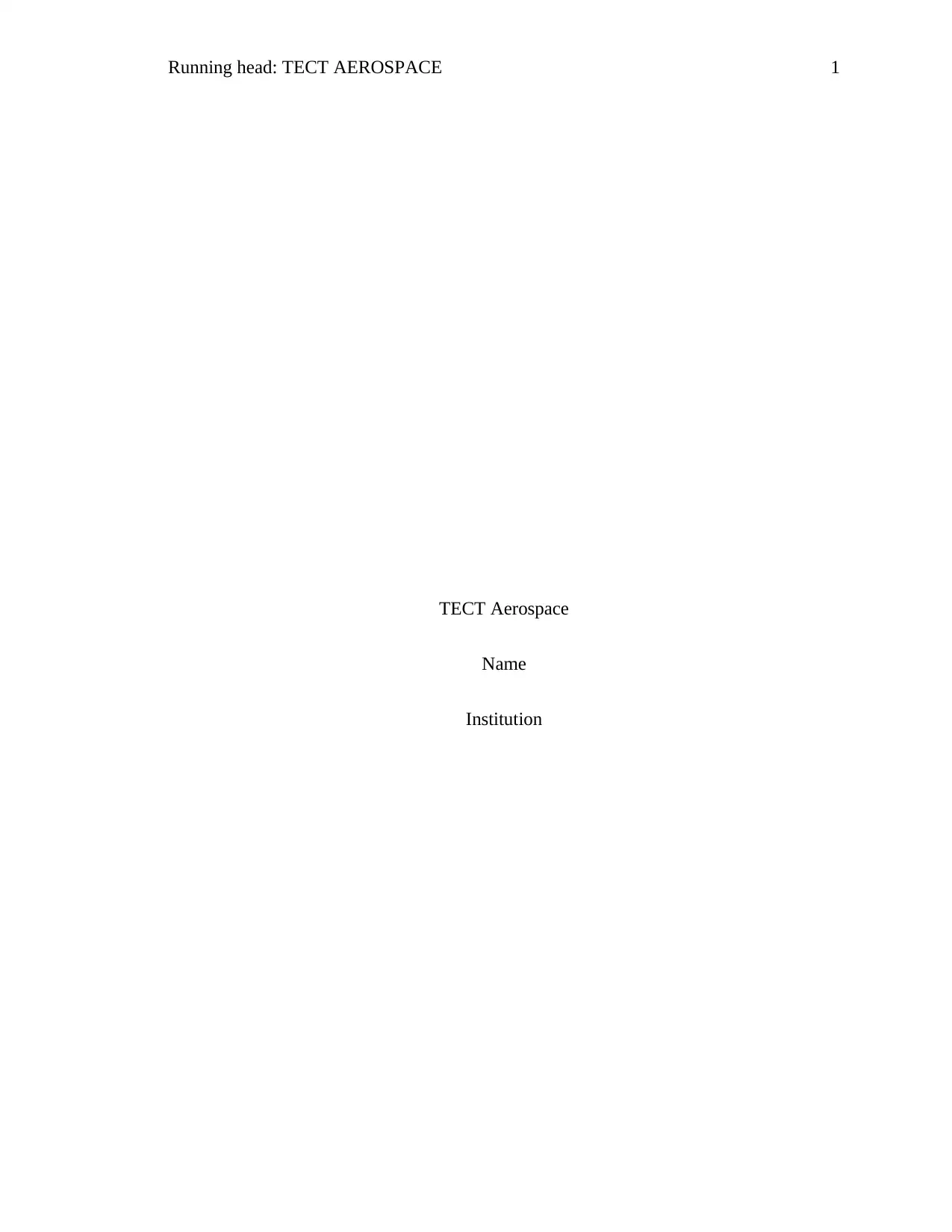
Running head: TECT AEROSPACE 1
TECT Aerospace
Name
Institution
TECT Aerospace
Name
Institution
Secure Best Marks with AI Grader
Need help grading? Try our AI Grader for instant feedback on your assignments.
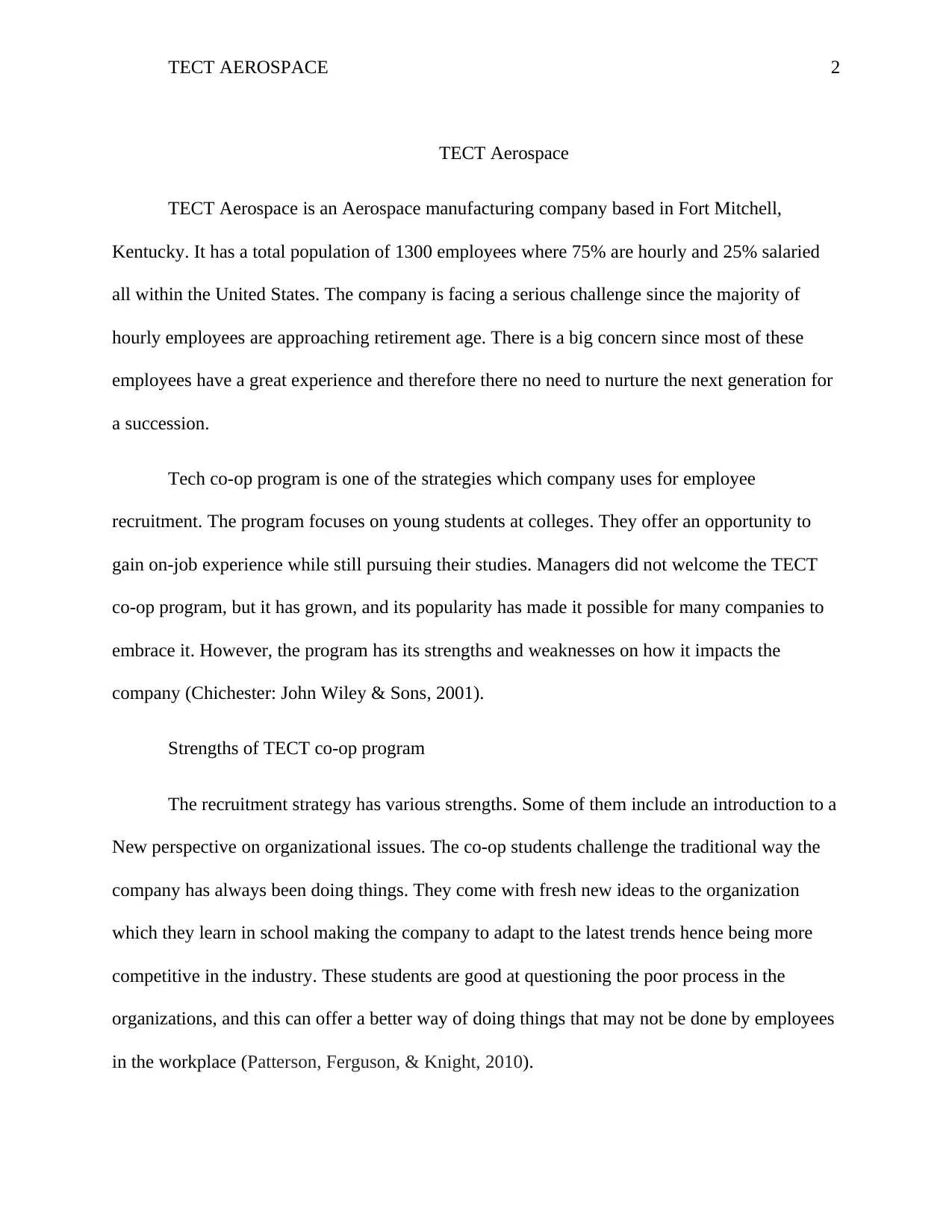
TECT AEROSPACE 2
TECT Aerospace
TECT Aerospace is an Aerospace manufacturing company based in Fort Mitchell,
Kentucky. It has a total population of 1300 employees where 75% are hourly and 25% salaried
all within the United States. The company is facing a serious challenge since the majority of
hourly employees are approaching retirement age. There is a big concern since most of these
employees have a great experience and therefore there no need to nurture the next generation for
a succession.
Tech co-op program is one of the strategies which company uses for employee
recruitment. The program focuses on young students at colleges. They offer an opportunity to
gain on-job experience while still pursuing their studies. Managers did not welcome the TECT
co-op program, but it has grown, and its popularity has made it possible for many companies to
embrace it. However, the program has its strengths and weaknesses on how it impacts the
company (Chichester: John Wiley & Sons, 2001).
Strengths of TECT co-op program
The recruitment strategy has various strengths. Some of them include an introduction to a
New perspective on organizational issues. The co-op students challenge the traditional way the
company has always been doing things. They come with fresh new ideas to the organization
which they learn in school making the company to adapt to the latest trends hence being more
competitive in the industry. These students are good at questioning the poor process in the
organizations, and this can offer a better way of doing things that may not be done by employees
in the workplace (Patterson, Ferguson, & Knight, 2010).
TECT Aerospace
TECT Aerospace is an Aerospace manufacturing company based in Fort Mitchell,
Kentucky. It has a total population of 1300 employees where 75% are hourly and 25% salaried
all within the United States. The company is facing a serious challenge since the majority of
hourly employees are approaching retirement age. There is a big concern since most of these
employees have a great experience and therefore there no need to nurture the next generation for
a succession.
Tech co-op program is one of the strategies which company uses for employee
recruitment. The program focuses on young students at colleges. They offer an opportunity to
gain on-job experience while still pursuing their studies. Managers did not welcome the TECT
co-op program, but it has grown, and its popularity has made it possible for many companies to
embrace it. However, the program has its strengths and weaknesses on how it impacts the
company (Chichester: John Wiley & Sons, 2001).
Strengths of TECT co-op program
The recruitment strategy has various strengths. Some of them include an introduction to a
New perspective on organizational issues. The co-op students challenge the traditional way the
company has always been doing things. They come with fresh new ideas to the organization
which they learn in school making the company to adapt to the latest trends hence being more
competitive in the industry. These students are good at questioning the poor process in the
organizations, and this can offer a better way of doing things that may not be done by employees
in the workplace (Patterson, Ferguson, & Knight, 2010).
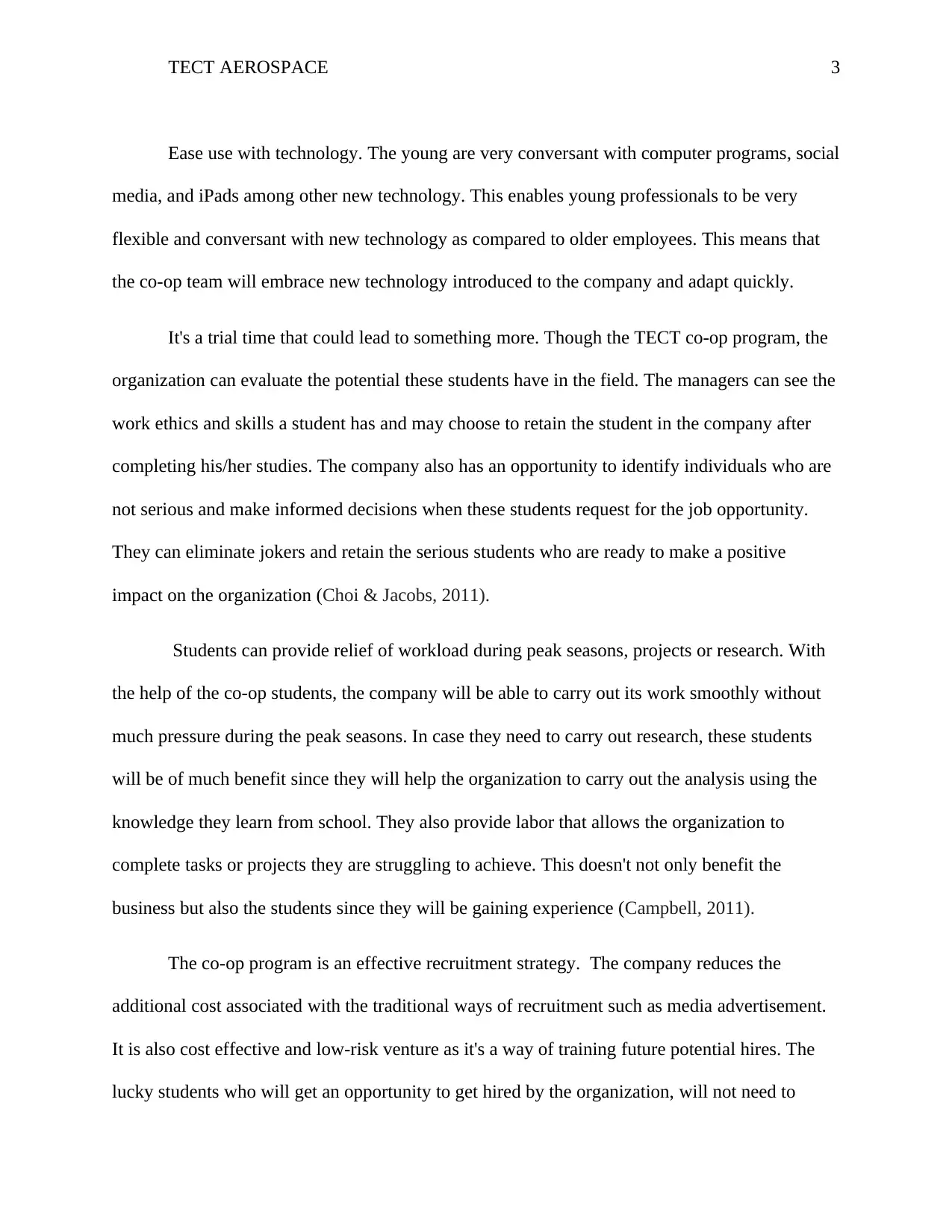
TECT AEROSPACE 3
Ease use with technology. The young are very conversant with computer programs, social
media, and iPads among other new technology. This enables young professionals to be very
flexible and conversant with new technology as compared to older employees. This means that
the co-op team will embrace new technology introduced to the company and adapt quickly.
It's a trial time that could lead to something more. Though the TECT co-op program, the
organization can evaluate the potential these students have in the field. The managers can see the
work ethics and skills a student has and may choose to retain the student in the company after
completing his/her studies. The company also has an opportunity to identify individuals who are
not serious and make informed decisions when these students request for the job opportunity.
They can eliminate jokers and retain the serious students who are ready to make a positive
impact on the organization (Choi & Jacobs, 2011).
Students can provide relief of workload during peak seasons, projects or research. With
the help of the co-op students, the company will be able to carry out its work smoothly without
much pressure during the peak seasons. In case they need to carry out research, these students
will be of much benefit since they will help the organization to carry out the analysis using the
knowledge they learn from school. They also provide labor that allows the organization to
complete tasks or projects they are struggling to achieve. This doesn't not only benefit the
business but also the students since they will be gaining experience (Campbell, 2011).
The co-op program is an effective recruitment strategy. The company reduces the
additional cost associated with the traditional ways of recruitment such as media advertisement.
It is also cost effective and low-risk venture as it's a way of training future potential hires. The
lucky students who will get an opportunity to get hired by the organization, will not need to
Ease use with technology. The young are very conversant with computer programs, social
media, and iPads among other new technology. This enables young professionals to be very
flexible and conversant with new technology as compared to older employees. This means that
the co-op team will embrace new technology introduced to the company and adapt quickly.
It's a trial time that could lead to something more. Though the TECT co-op program, the
organization can evaluate the potential these students have in the field. The managers can see the
work ethics and skills a student has and may choose to retain the student in the company after
completing his/her studies. The company also has an opportunity to identify individuals who are
not serious and make informed decisions when these students request for the job opportunity.
They can eliminate jokers and retain the serious students who are ready to make a positive
impact on the organization (Choi & Jacobs, 2011).
Students can provide relief of workload during peak seasons, projects or research. With
the help of the co-op students, the company will be able to carry out its work smoothly without
much pressure during the peak seasons. In case they need to carry out research, these students
will be of much benefit since they will help the organization to carry out the analysis using the
knowledge they learn from school. They also provide labor that allows the organization to
complete tasks or projects they are struggling to achieve. This doesn't not only benefit the
business but also the students since they will be gaining experience (Campbell, 2011).
The co-op program is an effective recruitment strategy. The company reduces the
additional cost associated with the traditional ways of recruitment such as media advertisement.
It is also cost effective and low-risk venture as it's a way of training future potential hires. The
lucky students who will get an opportunity to get hired by the organization, will not need to
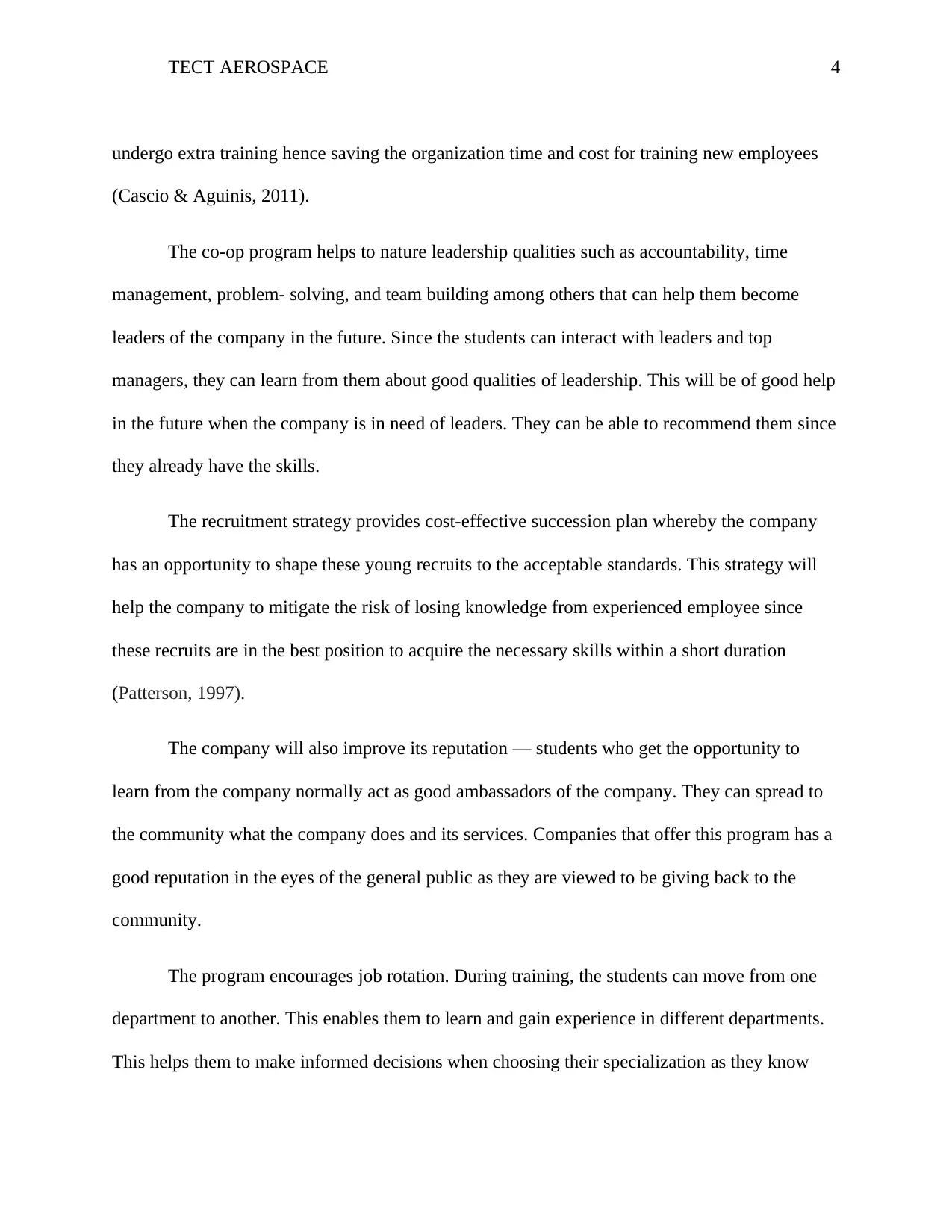
TECT AEROSPACE 4
undergo extra training hence saving the organization time and cost for training new employees
(Cascio & Aguinis, 2011).
The co-op program helps to nature leadership qualities such as accountability, time
management, problem- solving, and team building among others that can help them become
leaders of the company in the future. Since the students can interact with leaders and top
managers, they can learn from them about good qualities of leadership. This will be of good help
in the future when the company is in need of leaders. They can be able to recommend them since
they already have the skills.
The recruitment strategy provides cost-effective succession plan whereby the company
has an opportunity to shape these young recruits to the acceptable standards. This strategy will
help the company to mitigate the risk of losing knowledge from experienced employee since
these recruits are in the best position to acquire the necessary skills within a short duration
(Patterson, 1997).
The company will also improve its reputation — students who get the opportunity to
learn from the company normally act as good ambassadors of the company. They can spread to
the community what the company does and its services. Companies that offer this program has a
good reputation in the eyes of the general public as they are viewed to be giving back to the
community.
The program encourages job rotation. During training, the students can move from one
department to another. This enables them to learn and gain experience in different departments.
This helps them to make informed decisions when choosing their specialization as they know
undergo extra training hence saving the organization time and cost for training new employees
(Cascio & Aguinis, 2011).
The co-op program helps to nature leadership qualities such as accountability, time
management, problem- solving, and team building among others that can help them become
leaders of the company in the future. Since the students can interact with leaders and top
managers, they can learn from them about good qualities of leadership. This will be of good help
in the future when the company is in need of leaders. They can be able to recommend them since
they already have the skills.
The recruitment strategy provides cost-effective succession plan whereby the company
has an opportunity to shape these young recruits to the acceptable standards. This strategy will
help the company to mitigate the risk of losing knowledge from experienced employee since
these recruits are in the best position to acquire the necessary skills within a short duration
(Patterson, 1997).
The company will also improve its reputation — students who get the opportunity to
learn from the company normally act as good ambassadors of the company. They can spread to
the community what the company does and its services. Companies that offer this program has a
good reputation in the eyes of the general public as they are viewed to be giving back to the
community.
The program encourages job rotation. During training, the students can move from one
department to another. This enables them to learn and gain experience in different departments.
This helps them to make informed decisions when choosing their specialization as they know
Secure Best Marks with AI Grader
Need help grading? Try our AI Grader for instant feedback on your assignments.
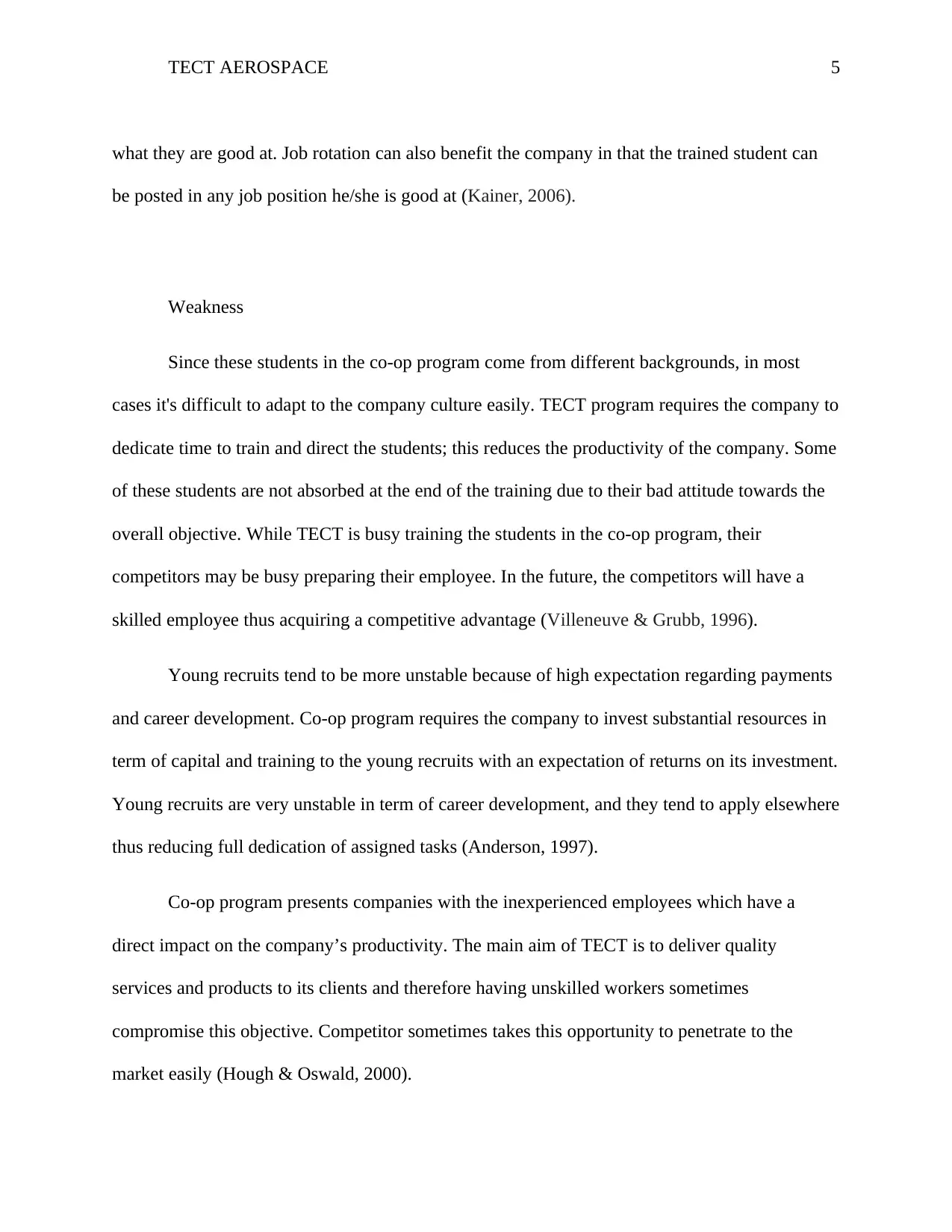
TECT AEROSPACE 5
what they are good at. Job rotation can also benefit the company in that the trained student can
be posted in any job position he/she is good at (Kainer, 2006).
Weakness
Since these students in the co-op program come from different backgrounds, in most
cases it's difficult to adapt to the company culture easily. TECT program requires the company to
dedicate time to train and direct the students; this reduces the productivity of the company. Some
of these students are not absorbed at the end of the training due to their bad attitude towards the
overall objective. While TECT is busy training the students in the co-op program, their
competitors may be busy preparing their employee. In the future, the competitors will have a
skilled employee thus acquiring a competitive advantage (Villeneuve & Grubb, 1996).
Young recruits tend to be more unstable because of high expectation regarding payments
and career development. Co-op program requires the company to invest substantial resources in
term of capital and training to the young recruits with an expectation of returns on its investment.
Young recruits are very unstable in term of career development, and they tend to apply elsewhere
thus reducing full dedication of assigned tasks (Anderson, 1997).
Co-op program presents companies with the inexperienced employees which have a
direct impact on the company’s productivity. The main aim of TECT is to deliver quality
services and products to its clients and therefore having unskilled workers sometimes
compromise this objective. Competitor sometimes takes this opportunity to penetrate to the
market easily (Hough & Oswald, 2000).
what they are good at. Job rotation can also benefit the company in that the trained student can
be posted in any job position he/she is good at (Kainer, 2006).
Weakness
Since these students in the co-op program come from different backgrounds, in most
cases it's difficult to adapt to the company culture easily. TECT program requires the company to
dedicate time to train and direct the students; this reduces the productivity of the company. Some
of these students are not absorbed at the end of the training due to their bad attitude towards the
overall objective. While TECT is busy training the students in the co-op program, their
competitors may be busy preparing their employee. In the future, the competitors will have a
skilled employee thus acquiring a competitive advantage (Villeneuve & Grubb, 1996).
Young recruits tend to be more unstable because of high expectation regarding payments
and career development. Co-op program requires the company to invest substantial resources in
term of capital and training to the young recruits with an expectation of returns on its investment.
Young recruits are very unstable in term of career development, and they tend to apply elsewhere
thus reducing full dedication of assigned tasks (Anderson, 1997).
Co-op program presents companies with the inexperienced employees which have a
direct impact on the company’s productivity. The main aim of TECT is to deliver quality
services and products to its clients and therefore having unskilled workers sometimes
compromise this objective. Competitor sometimes takes this opportunity to penetrate to the
market easily (Hough & Oswald, 2000).
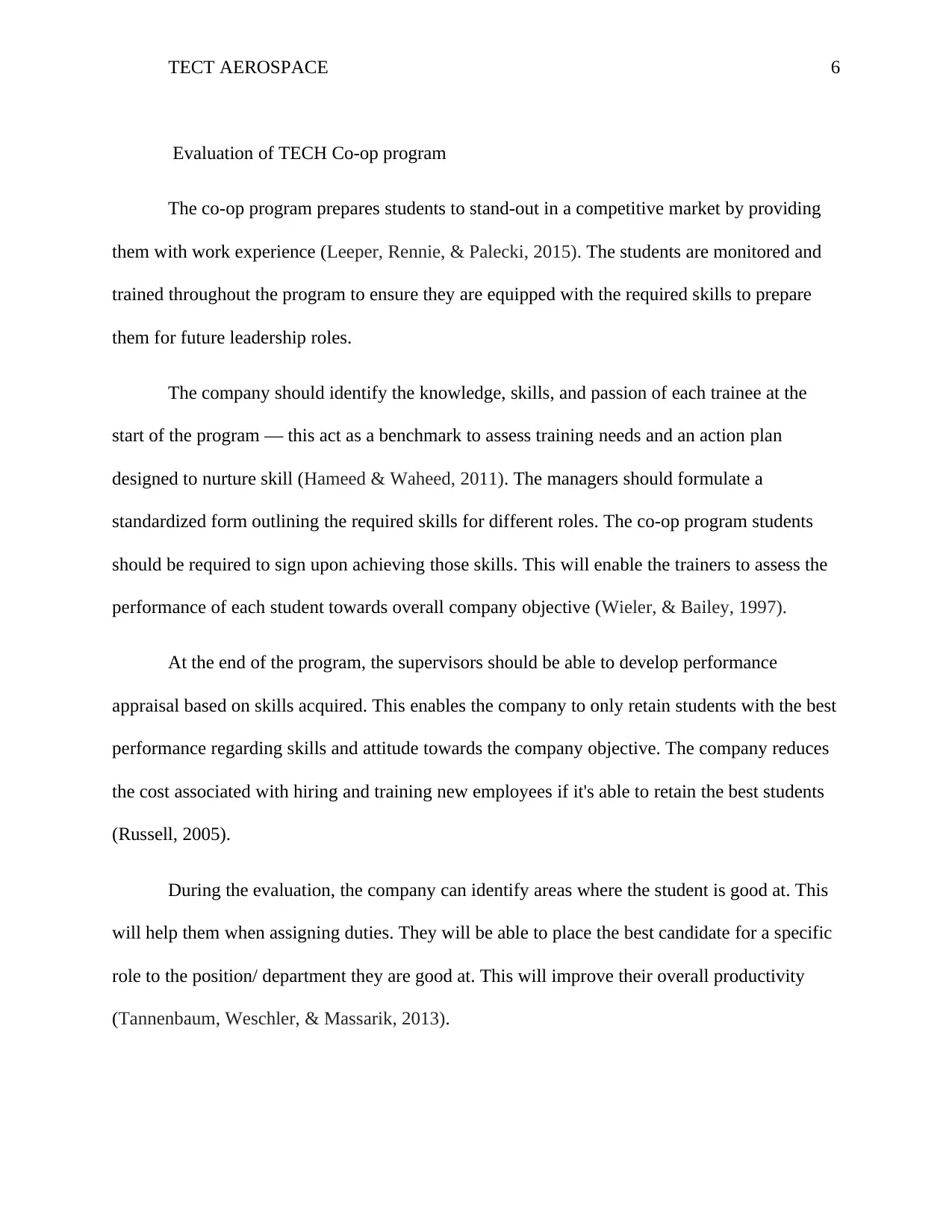
TECT AEROSPACE 6
Evaluation of TECH Co-op program
The co-op program prepares students to stand-out in a competitive market by providing
them with work experience (Leeper, Rennie, & Palecki, 2015). The students are monitored and
trained throughout the program to ensure they are equipped with the required skills to prepare
them for future leadership roles.
The company should identify the knowledge, skills, and passion of each trainee at the
start of the program — this act as a benchmark to assess training needs and an action plan
designed to nurture skill (Hameed & Waheed, 2011). The managers should formulate a
standardized form outlining the required skills for different roles. The co-op program students
should be required to sign upon achieving those skills. This will enable the trainers to assess the
performance of each student towards overall company objective (Wieler, & Bailey, 1997).
At the end of the program, the supervisors should be able to develop performance
appraisal based on skills acquired. This enables the company to only retain students with the best
performance regarding skills and attitude towards the company objective. The company reduces
the cost associated with hiring and training new employees if it's able to retain the best students
(Russell, 2005).
During the evaluation, the company can identify areas where the student is good at. This
will help them when assigning duties. They will be able to place the best candidate for a specific
role to the position/ department they are good at. This will improve their overall productivity
(Tannenbaum, Weschler, & Massarik, 2013).
Evaluation of TECH Co-op program
The co-op program prepares students to stand-out in a competitive market by providing
them with work experience (Leeper, Rennie, & Palecki, 2015). The students are monitored and
trained throughout the program to ensure they are equipped with the required skills to prepare
them for future leadership roles.
The company should identify the knowledge, skills, and passion of each trainee at the
start of the program — this act as a benchmark to assess training needs and an action plan
designed to nurture skill (Hameed & Waheed, 2011). The managers should formulate a
standardized form outlining the required skills for different roles. The co-op program students
should be required to sign upon achieving those skills. This will enable the trainers to assess the
performance of each student towards overall company objective (Wieler, & Bailey, 1997).
At the end of the program, the supervisors should be able to develop performance
appraisal based on skills acquired. This enables the company to only retain students with the best
performance regarding skills and attitude towards the company objective. The company reduces
the cost associated with hiring and training new employees if it's able to retain the best students
(Russell, 2005).
During the evaluation, the company can identify areas where the student is good at. This
will help them when assigning duties. They will be able to place the best candidate for a specific
role to the position/ department they are good at. This will improve their overall productivity
(Tannenbaum, Weschler, & Massarik, 2013).
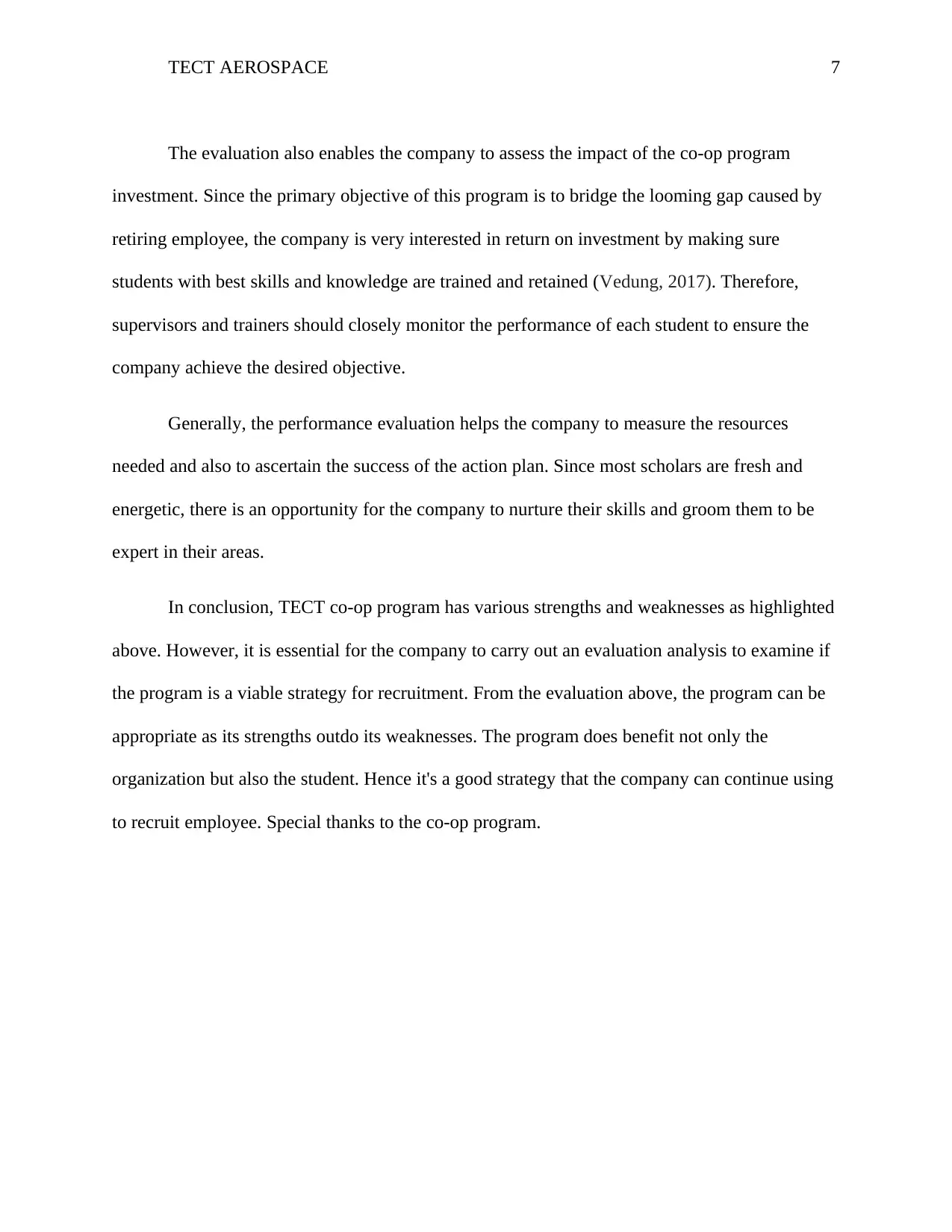
TECT AEROSPACE 7
The evaluation also enables the company to assess the impact of the co-op program
investment. Since the primary objective of this program is to bridge the looming gap caused by
retiring employee, the company is very interested in return on investment by making sure
students with best skills and knowledge are trained and retained (Vedung, 2017). Therefore,
supervisors and trainers should closely monitor the performance of each student to ensure the
company achieve the desired objective.
Generally, the performance evaluation helps the company to measure the resources
needed and also to ascertain the success of the action plan. Since most scholars are fresh and
energetic, there is an opportunity for the company to nurture their skills and groom them to be
expert in their areas.
In conclusion, TECT co-op program has various strengths and weaknesses as highlighted
above. However, it is essential for the company to carry out an evaluation analysis to examine if
the program is a viable strategy for recruitment. From the evaluation above, the program can be
appropriate as its strengths outdo its weaknesses. The program does benefit not only the
organization but also the student. Hence it's a good strategy that the company can continue using
to recruit employee. Special thanks to the co-op program.
The evaluation also enables the company to assess the impact of the co-op program
investment. Since the primary objective of this program is to bridge the looming gap caused by
retiring employee, the company is very interested in return on investment by making sure
students with best skills and knowledge are trained and retained (Vedung, 2017). Therefore,
supervisors and trainers should closely monitor the performance of each student to ensure the
company achieve the desired objective.
Generally, the performance evaluation helps the company to measure the resources
needed and also to ascertain the success of the action plan. Since most scholars are fresh and
energetic, there is an opportunity for the company to nurture their skills and groom them to be
expert in their areas.
In conclusion, TECT co-op program has various strengths and weaknesses as highlighted
above. However, it is essential for the company to carry out an evaluation analysis to examine if
the program is a viable strategy for recruitment. From the evaluation above, the program can be
appropriate as its strengths outdo its weaknesses. The program does benefit not only the
organization but also the student. Hence it's a good strategy that the company can continue using
to recruit employee. Special thanks to the co-op program.
Paraphrase This Document
Need a fresh take? Get an instant paraphrase of this document with our AI Paraphraser
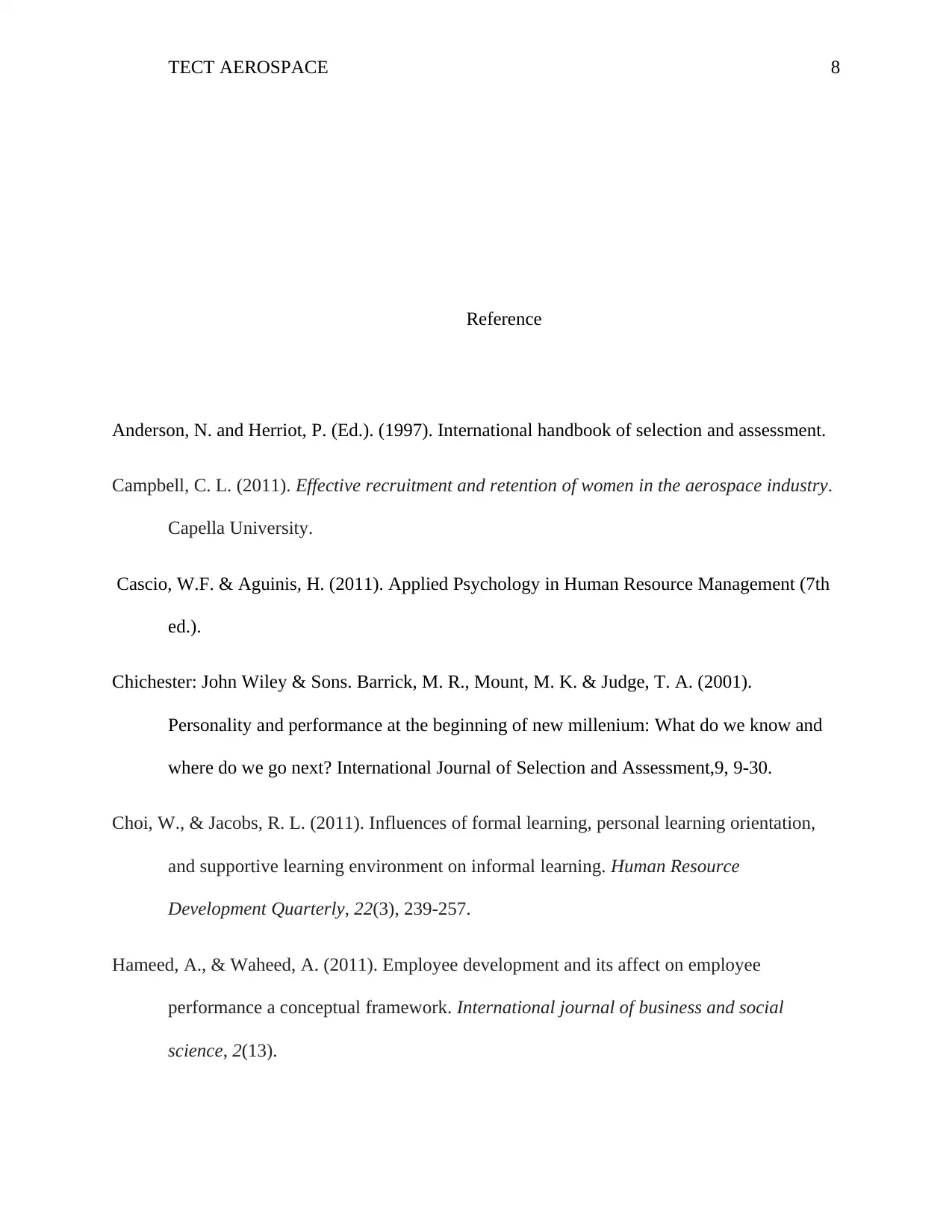
TECT AEROSPACE 8
Reference
Anderson, N. and Herriot, P. (Ed.). (1997). International handbook of selection and assessment.
Campbell, C. L. (2011). Effective recruitment and retention of women in the aerospace industry.
Capella University.
Cascio, W.F. & Aguinis, H. (2011). Applied Psychology in Human Resource Management (7th
ed.).
Chichester: John Wiley & Sons. Barrick, M. R., Mount, M. K. & Judge, T. A. (2001).
Personality and performance at the beginning of new millenium: What do we know and
where do we go next? International Journal of Selection and Assessment,9, 9-30.
Choi, W., & Jacobs, R. L. (2011). Influences of formal learning, personal learning orientation,
and supportive learning environment on informal learning. Human Resource
Development Quarterly, 22(3), 239-257.
Hameed, A., & Waheed, A. (2011). Employee development and its affect on employee
performance a conceptual framework. International journal of business and social
science, 2(13).
Reference
Anderson, N. and Herriot, P. (Ed.). (1997). International handbook of selection and assessment.
Campbell, C. L. (2011). Effective recruitment and retention of women in the aerospace industry.
Capella University.
Cascio, W.F. & Aguinis, H. (2011). Applied Psychology in Human Resource Management (7th
ed.).
Chichester: John Wiley & Sons. Barrick, M. R., Mount, M. K. & Judge, T. A. (2001).
Personality and performance at the beginning of new millenium: What do we know and
where do we go next? International Journal of Selection and Assessment,9, 9-30.
Choi, W., & Jacobs, R. L. (2011). Influences of formal learning, personal learning orientation,
and supportive learning environment on informal learning. Human Resource
Development Quarterly, 22(3), 239-257.
Hameed, A., & Waheed, A. (2011). Employee development and its affect on employee
performance a conceptual framework. International journal of business and social
science, 2(13).
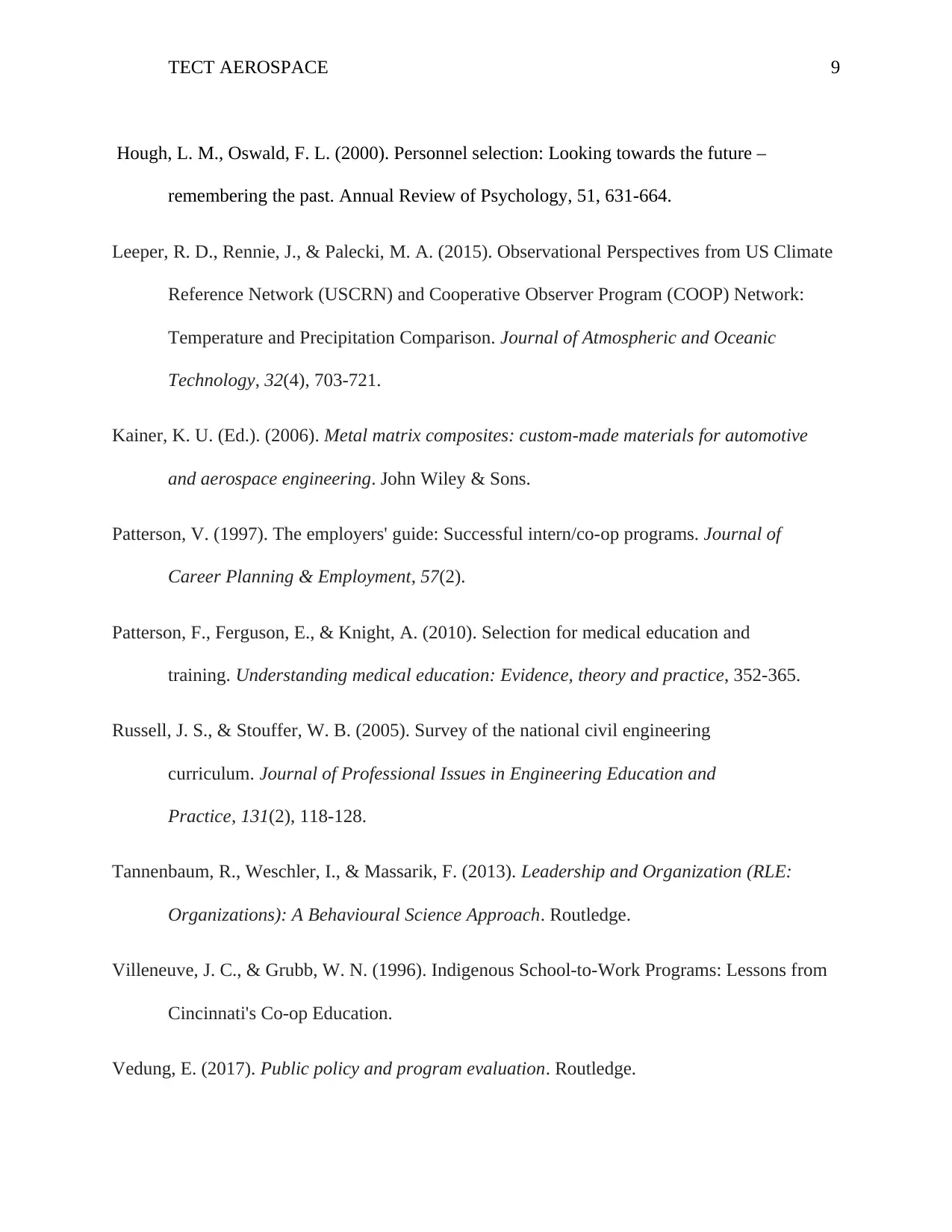
TECT AEROSPACE 9
Hough, L. M., Oswald, F. L. (2000). Personnel selection: Looking towards the future –
remembering the past. Annual Review of Psychology, 51, 631-664.
Leeper, R. D., Rennie, J., & Palecki, M. A. (2015). Observational Perspectives from US Climate
Reference Network (USCRN) and Cooperative Observer Program (COOP) Network:
Temperature and Precipitation Comparison. Journal of Atmospheric and Oceanic
Technology, 32(4), 703-721.
Kainer, K. U. (Ed.). (2006). Metal matrix composites: custom-made materials for automotive
and aerospace engineering. John Wiley & Sons.
Patterson, V. (1997). The employers' guide: Successful intern/co-op programs. Journal of
Career Planning & Employment, 57(2).
Patterson, F., Ferguson, E., & Knight, A. (2010). Selection for medical education and
training. Understanding medical education: Evidence, theory and practice, 352-365.
Russell, J. S., & Stouffer, W. B. (2005). Survey of the national civil engineering
curriculum. Journal of Professional Issues in Engineering Education and
Practice, 131(2), 118-128.
Tannenbaum, R., Weschler, I., & Massarik, F. (2013). Leadership and Organization (RLE:
Organizations): A Behavioural Science Approach. Routledge.
Villeneuve, J. C., & Grubb, W. N. (1996). Indigenous School-to-Work Programs: Lessons from
Cincinnati's Co-op Education.
Vedung, E. (2017). Public policy and program evaluation. Routledge.
Hough, L. M., Oswald, F. L. (2000). Personnel selection: Looking towards the future –
remembering the past. Annual Review of Psychology, 51, 631-664.
Leeper, R. D., Rennie, J., & Palecki, M. A. (2015). Observational Perspectives from US Climate
Reference Network (USCRN) and Cooperative Observer Program (COOP) Network:
Temperature and Precipitation Comparison. Journal of Atmospheric and Oceanic
Technology, 32(4), 703-721.
Kainer, K. U. (Ed.). (2006). Metal matrix composites: custom-made materials for automotive
and aerospace engineering. John Wiley & Sons.
Patterson, V. (1997). The employers' guide: Successful intern/co-op programs. Journal of
Career Planning & Employment, 57(2).
Patterson, F., Ferguson, E., & Knight, A. (2010). Selection for medical education and
training. Understanding medical education: Evidence, theory and practice, 352-365.
Russell, J. S., & Stouffer, W. B. (2005). Survey of the national civil engineering
curriculum. Journal of Professional Issues in Engineering Education and
Practice, 131(2), 118-128.
Tannenbaum, R., Weschler, I., & Massarik, F. (2013). Leadership and Organization (RLE:
Organizations): A Behavioural Science Approach. Routledge.
Villeneuve, J. C., & Grubb, W. N. (1996). Indigenous School-to-Work Programs: Lessons from
Cincinnati's Co-op Education.
Vedung, E. (2017). Public policy and program evaluation. Routledge.
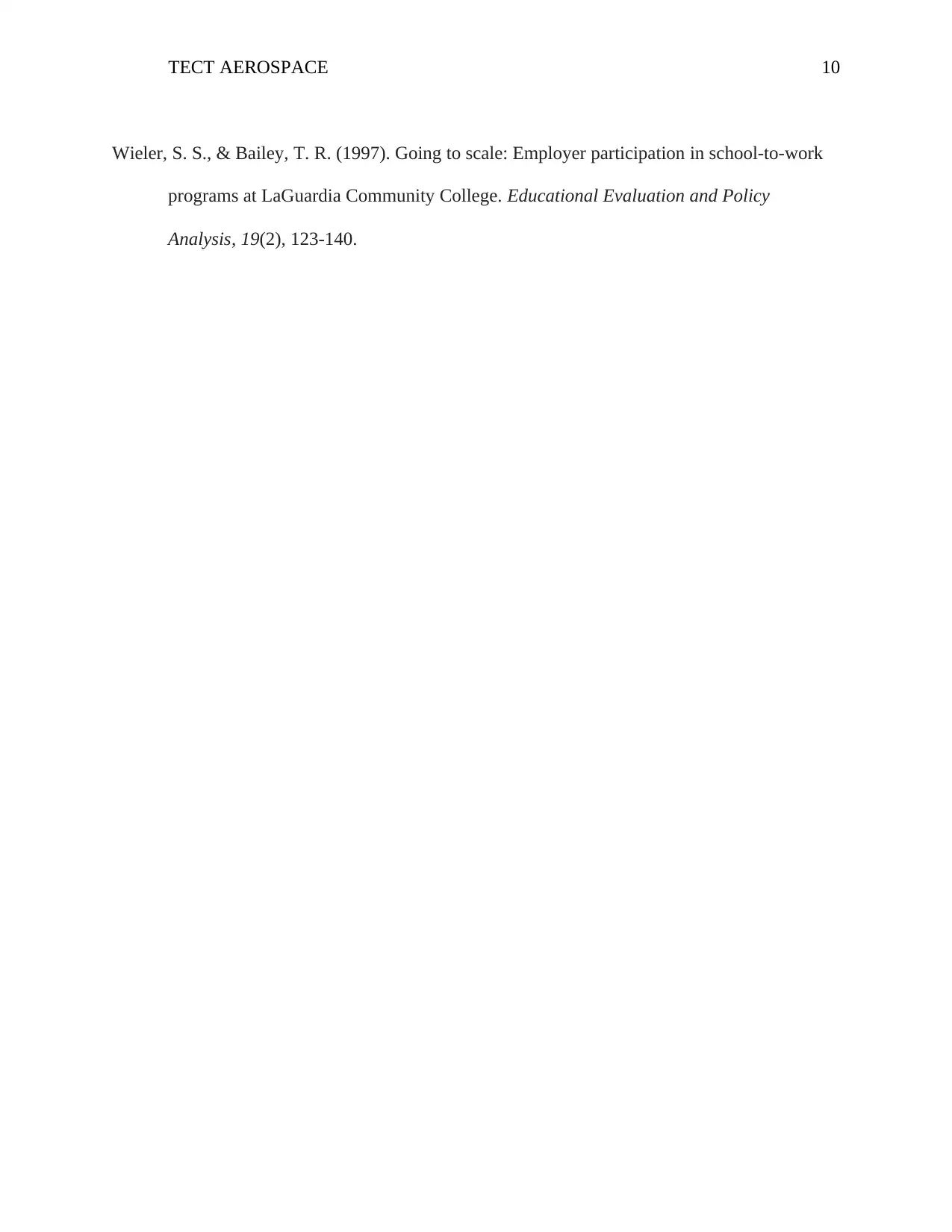
TECT AEROSPACE 10
Wieler, S. S., & Bailey, T. R. (1997). Going to scale: Employer participation in school-to-work
programs at LaGuardia Community College. Educational Evaluation and Policy
Analysis, 19(2), 123-140.
Wieler, S. S., & Bailey, T. R. (1997). Going to scale: Employer participation in school-to-work
programs at LaGuardia Community College. Educational Evaluation and Policy
Analysis, 19(2), 123-140.
1 out of 10
Your All-in-One AI-Powered Toolkit for Academic Success.
+13062052269
info@desklib.com
Available 24*7 on WhatsApp / Email
![[object Object]](/_next/static/media/star-bottom.7253800d.svg)
Unlock your academic potential
© 2024 | Zucol Services PVT LTD | All rights reserved.





